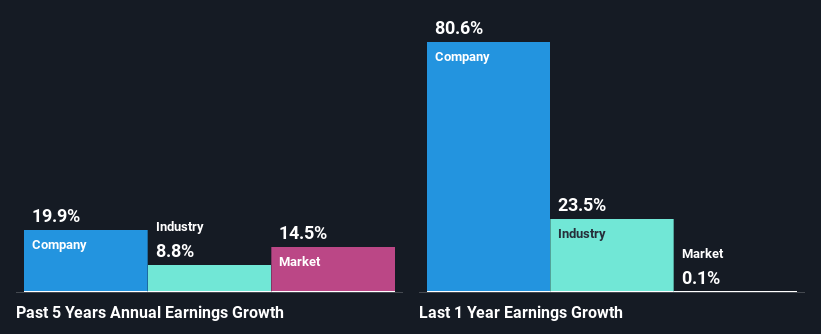Terex Corporation's (NYSE:TEX) Stock Is Going Strong: Is the Market Following Fundamentals?
Terex's (NYSE:TEX) stock is up by a considerable 16% over the past month. Since the market usually pay for a company’s long-term fundamentals, we decided to study the company’s key performance indicators to see if they could be influencing the market. In this article, we decided to focus on Terex's ROE.
Return on equity or ROE is an important factor to be considered by a shareholder because it tells them how effectively their capital is being reinvested. Put another way, it reveals the company's success at turning shareholder investments into profits.
Check out our latest analysis for Terex
How Is ROE Calculated?
Return on equity can be calculated by using the formula:
Return on Equity = Net Profit (from continuing operations) ÷ Shareholders' Equity
So, based on the above formula, the ROE for Terex is:
32% = US$481m ÷ US$1.5b (Based on the trailing twelve months to September 2023).
The 'return' is the profit over the last twelve months. So, this means that for every $1 of its shareholder's investments, the company generates a profit of $0.32.
What Has ROE Got To Do With Earnings Growth?
Thus far, we have learned that ROE measures how efficiently a company is generating its profits. Based on how much of its profits the company chooses to reinvest or "retain", we are then able to evaluate a company's future ability to generate profits. Generally speaking, other things being equal, firms with a high return on equity and profit retention, have a higher growth rate than firms that don’t share these attributes.
Terex's Earnings Growth And 32% ROE
First thing first, we like that Terex has an impressive ROE. Additionally, the company's ROE is higher compared to the industry average of 15% which is quite remarkable. This probably laid the groundwork for Terex's moderate 20% net income growth seen over the past five years.
Next, on comparing with the industry net income growth, we found that Terex's growth is quite high when compared to the industry average growth of 8.8% in the same period, which is great to see.
Earnings growth is a huge factor in stock valuation. What investors need to determine next is if the expected earnings growth, or the lack of it, is already built into the share price. By doing so, they will have an idea if the stock is headed into clear blue waters or if swampy waters await. Has the market priced in the future outlook for TEX? You can find out in our latest intrinsic value infographic research report.
Is Terex Using Its Retained Earnings Effectively?
Terex has a low three-year median payout ratio of 13%, meaning that the company retains the remaining 87% of its profits. This suggests that the management is reinvesting most of the profits to grow the business.
Moreover, Terex is determined to keep sharing its profits with shareholders which we infer from its long history of paying a dividend for at least ten years. Upon studying the latest analysts' consensus data, we found that the company is expected to keep paying out approximately 11% of its profits over the next three years. Still, forecasts suggest that Terex's future ROE will drop to 20% even though the the company's payout ratio is not expected to change by much.
Conclusion
On the whole, we feel that Terex's performance has been quite good. In particular, it's great to see that the company is investing heavily into its business and along with a high rate of return, that has resulted in a sizeable growth in its earnings. Having said that, on studying current analyst estimates, we were concerned to see that while the company has grown its earnings in the past, analysts expect its earnings to shrink in the future. To know more about the company's future earnings growth forecasts take a look at this free report on analyst forecasts for the company to find out more.
Have feedback on this article? Concerned about the content? Get in touch with us directly. Alternatively, email editorial-team (at) simplywallst.com.
This article by Simply Wall St is general in nature. We provide commentary based on historical data and analyst forecasts only using an unbiased methodology and our articles are not intended to be financial advice. It does not constitute a recommendation to buy or sell any stock, and does not take account of your objectives, or your financial situation. We aim to bring you long-term focused analysis driven by fundamental data. Note that our analysis may not factor in the latest price-sensitive company announcements or qualitative material. Simply Wall St has no position in any stocks mentioned.

